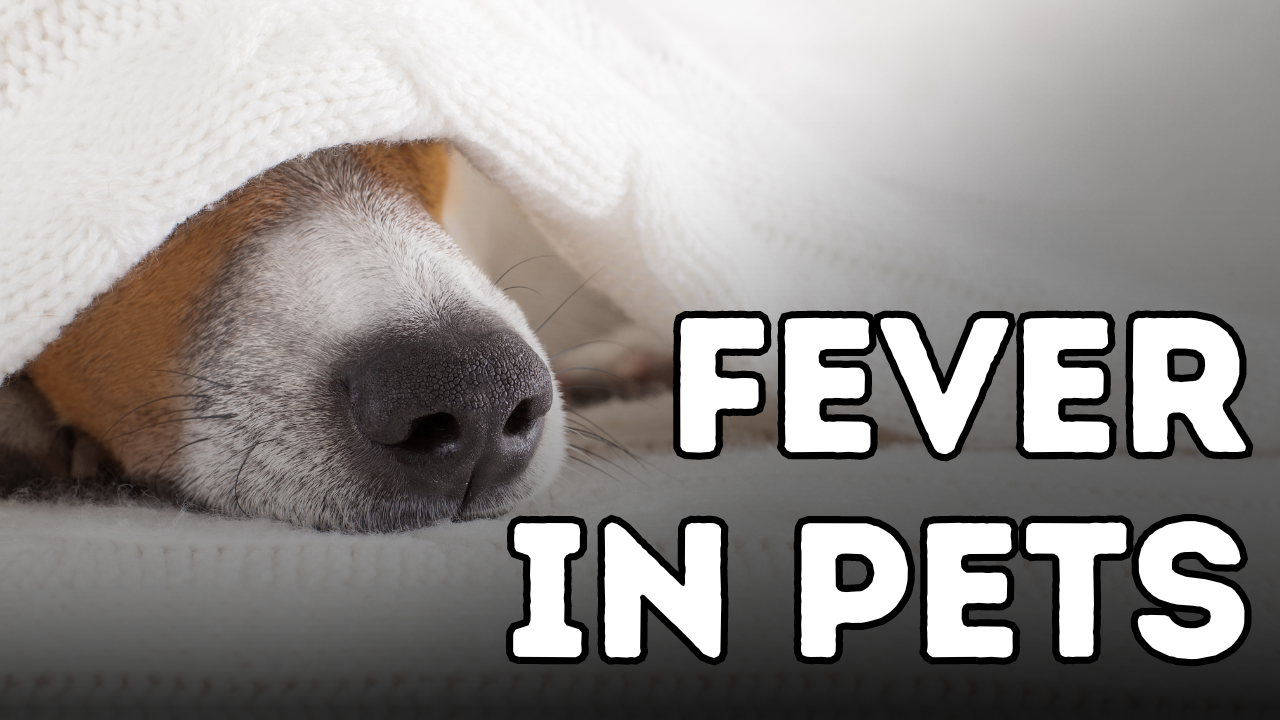What to Do If Your Pet Has a Fever: A Step-by-Step Guide

Being sick is NOT fun… and I can personally attest to that 🙁
Night sweats… .no energy… . sore throat…
When your dog or cat has a fever, they are experiencing much the same thing we do.
Unfortunately there are very few safe options that we can give our pets to help lower a fever, except CBD (Cannabidiol). And earlier animal research has hinted that fever triggered by a virus could be treated using CBD.
Dr. Jones’ Ultimate CBD for Dogs and Cats is a Full Spectrum CBD supplement in 100% Organic Cold Pressed Hemp Oil.


Fever in Dogs and Cats
Signs
The primary indication of a fever in dogs and cats is an above-normal body temperature. Pets may exhibit signs similar to humans, including a decreased appetite and lower energy levels. You may notice that your pet’s ears are hot to the touch, and they may pant excessively while indoors. Additionally, some pets might shiver, while others could have an elevated heart rate.
Causes
Fever typically results from a bacterial or viral infection, which helps hinder the growth of pathogens by elevating the body temperature. A crucial issue with fevers in pets is their tendency to stop drinking water, leading to dehydration. The normal body temperature for a dog is around 101°F (38°C), and for a cat, it is approximately 102°F (38.5°C). A fever is diagnosed when the temperature exceeds 103.5°F (39.5°C), which requires measuring the pet’s temperature via a rectal thermometer.
Solutions
What’s the Temperature?
Begin by taking your pet’s temperature to determine if it is elevated. If the reading is 103.5°F (39.5°C) or higher, your pet has a fever. Should the fever persist beyond 24 hours and your pet is not drinking, it is crucial to contact your veterinarian. Meanwhile, ensure they stay hydrated.
Keep Hydrated
Place multiple water bowls around the house to encourage drinking. If your pet refuses to drink, you can gently administer water using an eyedropper or a turkey baster. To replenish lost minerals, consider adding an electrolyte solution such as Pedialyte to their water. Offering flavors like chicken or beef broth, or tuna juice, may also entice them to drink.
Call Your Veterinarian
If the fever lasts more than 24 hours without your pet drinking, it’s important to consult your veterinarian.
Cool Compress
Applying a cool cloth to your pet’s belly can help reduce fever. This method provides quick cooling, especially on exposed skin, offering some relief to your pet.
Medications
- Aspirin: Safe for dogs (never for cats) to reduce fever. The recommended dosage is one 325 mg tablet per 40 pounds of body weight every 12 hours.
Herbal Remedies
- Echinacea, Myrrh, and Sage: These herbs are effective against microbes. Administer one drop per pound of body weight twice daily, or use a commercial product as directed.
- Elderberry and Honey: Effective for both viral and bacterial infections. Mix concentrated elderberry powder with honey and administer according to your pet’s weight.
- Olive Leaf Extract: Known for its antibacterial and antiviral properties, it can be particularly effective for skin and bladder infections or kennel cough. Dosage should start low and adjust based on tolerance.

Homeopathic Options
- Ferrum Phos: For fevers without severe symptoms, administer 30C every four hours for a few days.
- Hepar Sulph: Give one 30C tablet every six hours for up to three days.
- Arnica: Helps alleviate fever-related discomfort. Administer one 30C tablet per 40 pounds every four to six hours.
Cannabidiol (CBD)
Research indicates CBD can be effective in treating fever caused by pathogens, with a recommended dose of 3 mg per 10 pounds once or twice daily. It is especially useful for cats, as it is one of the few safe over-the-counter fever treatments available to them.
Always be prepared to manage fever in your pets, particularly with options like CBD that carry minimal side effects. Having these remedies at home can be a lifesaver.
P.S. This past weekend wasn’t the best as I was under the weather, but having my faithful companion, Tula, by my side made it bearable as we watched endless hours of Netflix.
P.P.S. Keeping CBD on hand is advisable, especially for cats, as they cannot take Aspirin and other common veterinary anti-inflammatories might pose risks.
Dr. Jones’ Ultimate CBD for Dogs and Cats

Thank you for this information. My cat has gingivitis and recently developed what I assume is cat flu. He was given a long acting antibiotic and anti inflammatory injection to help prior. His immune system must be very poor as he then began to get leaking eyes, congested nose, sneezing a few days later. I am reluctant to have his teeth pulled, but it seems the only solutions vets give. I have tried home remedies and paediatric otrivin but it’s three days later and he still seems congested. We can’t get CBD oil in Namibia. I crushed some multi vitamin tabs and gave it to him in a syringe with water. He will be 13 years old soon. Kind Regards Sigi
Hi there, we do have a video for you for your Gingivitis concern:
https://www.youtube.com/watch?v=pkefF4DukX8
For Cat flu:
SIGNS
The most obvious sign is a cat with a runny nose, often accompanied by swollen and runny eyes. Most cats will also be sneezing.
CAUSES
Two feline viruses are responsible for most cases of cat flu. Some cats can be infected as kittens and constantly harbor the virus, making them prone to repeated infections. In most cases, the virus will run its course in 7-10 days, so supportive care is needed.
SOLUTIONS
KEEP HER EATING. One of the best ways to help your cat’s immune system is by ensuring adequate food intake. Warm up her favorite canned food, or add a small amount (1/8 teaspoon) of garlic. If her regular food is not appetizing, then switch to canned tuna.
ORDER UP FLORIDA. Humidity is fabulous for easing congestion and improving breathing. Use a humidifier or put your cat in the bathroom and turn up the shower.
WIPE AWAY. Use a damp cloth to wipe crusted discharge around the nose and eyes.
OPEN THE AIRWAYS. For some cats with severe nasal congestion I have used Pediatric Otrivin. Use one drop in each nostril 3 times daily for 3-5 days.
AMINO ACID LYSINE. L-lysine has proven antiviral activity, and is a mainstay in treating and curing cats with recurrent Herpes Virus respiratory infections. It comes as a Veterinary paste, (Enisyl). The dose is 1 ml (250 mg) twice daily for at least 12 weeks.
SUPPLEMENTS. Vitamin C has antiviral activity. The feline dose is 250 mg daily. If this causes diarrhea, then lower the dose.
ACUPRESSURE:
For Immune Stimulation.
LI4. Medial metacarpus (between wrist and paw).
LI11. Lateral, and cranial to the elbow (point between humerus and radius).
ST36. Lateral knee.
GV14, C7 – T1. At base of the neck.
HERBAL:
Boosting the immune system is what is most important in recovering from the flu.
ECHINACEA. The most important herb, the cat dose is 1-2 drops per pound 3 times daily (of alcohol -free tincture). Give for no longer than 2 weeks.
LEMON BALM. Has been shown to have antiviral activity. Give 500 mg twice daily.
HOMEOPATHIC:
Several alternative veterinarians have had success using homeopathy in feline respiratory infections.
ALLIUM CEPA. Useful for watery nasal discharge causing sneezing; give one 30C twice daily for 5-7 days.
EUPHRASIA OFFICINALIS. Also effective for symptom relief; give one 30C twice daily for 5-7 days.
NUX VOMICA. Use this if the disease has vomiting /nausea as part of the symptoms. The typical dose is 30C twice daily.
PULSATILLA. Primarily for Urinary Tract Infections, but also for immunosuppression. Dose 30C every 4-6 hours for 2-3 days.
ARSENICUM. Often helpful with asthma, a primary cause of coughing in cats. Give Arsenicum 6C every 2-3 hours in a severe relapse then the 30C dose once a week.
PREVENTIVE. If your cat is outdoors and exposed to other cats, ensure that he is vaccinated with the two flu viruses. These vaccines only need to be given every 3 years once your cat is an adult.
Really useful and clear info! I like how this breaks down the signs of fever and easy first steps you can take at home to help your pet feel better. Thanks for the helpful guidance!